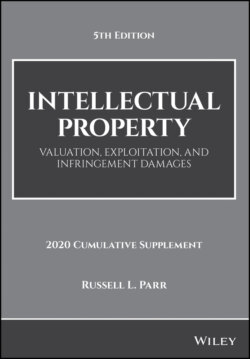Читать книгу Intellectual Property - Russell L. Parr - Страница 7
ОглавлениеPREFACE
This is the 2020 cumulative supplement to the fifth edition of Intellectual Property: Valuation, Exploitation, and Infringement Damages. It contains the following chapters.
CHAPTER 2A—SCANDALOUS TRADEMARKS
A new category of trademarks has emerged from the courts. Section 2(a) of the Lanham Act says that the USPTO may refuse to register any trademark that “consists of or comprises immoral, deceptive, or scandalous matter; or matter which may disparage or falsely suggest a connection with persons, living or dead, institutions, beliefs, or national symbols, or bring them into contempt or disrepute.” Recently, the U.S. Supreme Court struck down the Lanham Act's disparagement clause as unconstitutional in Matal v. Tam.1
CHAPTER 3A—ASSEMBLED WORK FORCES ARE VALUABLE BUT MAYBE NOT THE CHIEF EXECUTIVE OFFICER
Chief executive officers (CEOs) are the most expensive employee at a company. Their pay packages can include pay, bonuses, shares of stock, and stock options. Boards of Directors try to tie CEO compensation to company and share price performance but the results do not always work out. This new section presents evidence that CEOs are often over-rewarded for marginal company performance. When valuing an assembled workforce, special considerations are needed when considering the CEO.
CHAPTER 16A—ROYALTY RATES FOR LICENSING, DATA SOURCES
This chapter provides information about resources that are available for discovering royalty rate data that can serve as guidance for use in licensing agreements.
NEW CHAPTER 16B—ROYALTY RATE PRIMER PRESENTATION
Royalty rates and licensing are common knowledge to intellectual property experts like IP lawyers, licensing executives, and IP consultants, but for many others the basics of royalty rates are elusive. This new chapter outlines royalty rate fundamentals that IP executives can present to other key players of management who need to understand what the licensing executives are talking about. This chapter is provided in response to many requests from within the intellectual property world for a primer tool they can use to gain buy-in from others in their organization. It is written in the first person.
CHAPTER 27A—EXMARK ESTABLISHES NEW DAMAGES MODEL
In Exmark Manufacturing Company v. Briggs & Stratton Power, the U.S. Court of Appeals for the Federal Circuit approved a reasonable royalty damages theory based on the total value of an accused product, even though the patented invention was only part of a multicomponent product. Previously, apportionment was handled at the royalty base. Now, the entire value of the product can be used as the base and apportionment can be handled with an appropriate royalty rate.
APPENDIX C-1—FOOD & BEVERAGE INDUSTRY ROYALTY RATES AND SUPPORT FROM THE 25% RULE
Royalty rate data from Royalty Rates for Trademarks & Copyrights, published by IPRA, Inc., is reported along with a discussion of the state of the food and beverage industry. Generally, the food and beverage industry is very competitive, resulting in thin profit margins, and royalty rates for food and beverage trademarks reflect the low profit margins with low royalty rates. This supplemental chapter presents a discussion about the stresses in the food and beverage industry along with royalty rates found in the industry. In some cases, relatively high royalty rates are being paid even in an industry known for low profit margins. This may be a sign of desperation as industry participants attempt to reshape their companies and address new and fundamental shifts in the marketplace.
The data presented in this new section is then compared to royalty rates indicated from application of the 25% rule.
